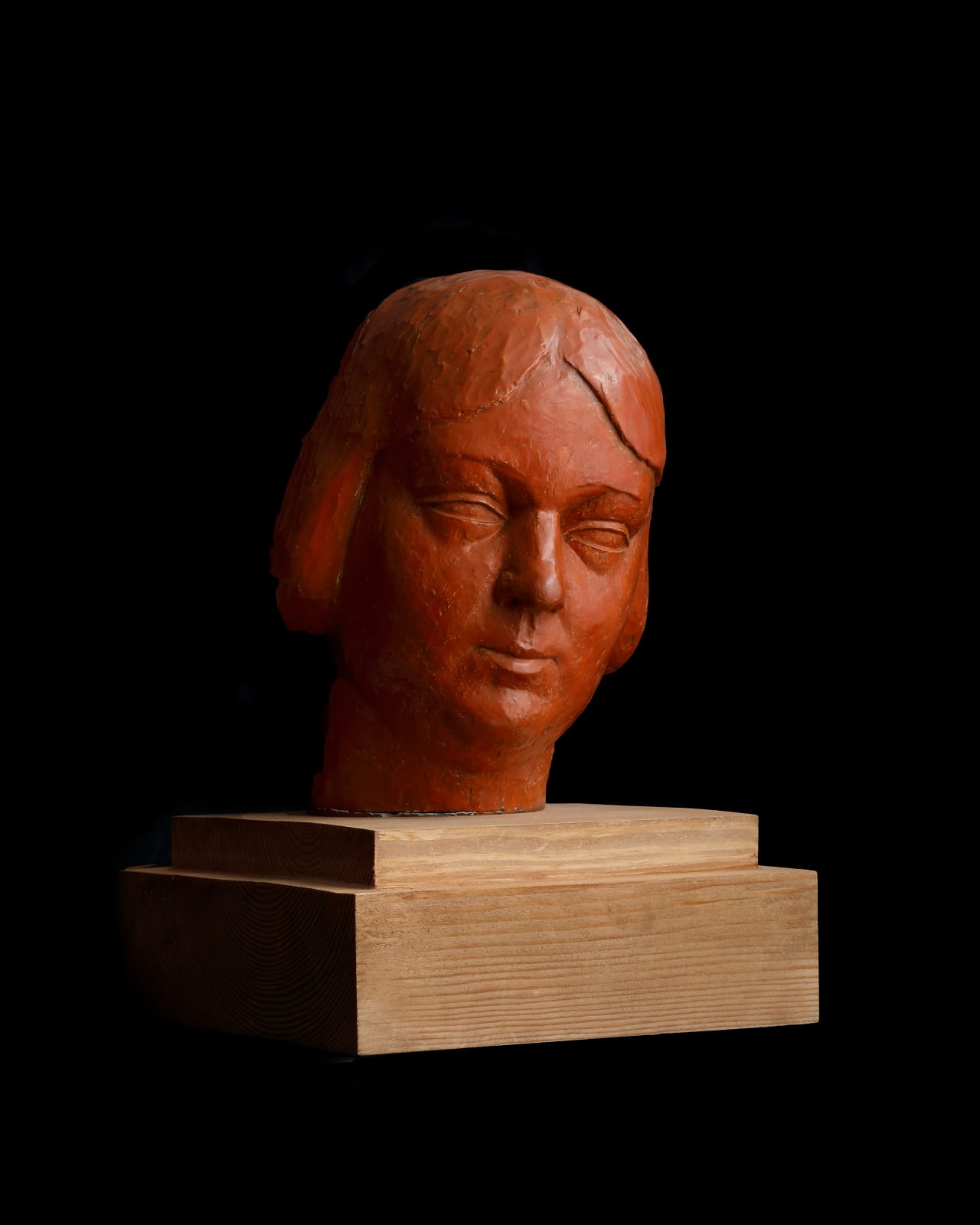
Stephen Tomlin
Stephen Tomlin’s strikingly modernist sculpture of Bingham captures her attentively leaning left, which she did so distinctly when listening to the people she most cherished. Tomlin’s striking characterisation was sculpted at the height of a fervid, but doomed relationship with the artist, which ended with Bingham leaving Tomlin, and returning to her teenage love.
Bingham was a charismatic jazz-age journalist and a wealthy American socialite who in mid-life won the hearts of the Bloomsbury Group. Born in Louisville, Kentucky in 1901, her father’s family made their fortune in the textiles business, her mother’s in engineering. She was raised to be a charming, strong, and competitive young woman, despite the profound trauma of witnessing the death of her mother in a horrific car accident when Bingham was just twelve years old. From this point on, Henrietta became the focus of her father’s - often controlling - attention and adoration.
Henrietta was likely dyslexic though this did not deter her from attending university. She was accepted into Smith College, Massachusetts, and it was here that she met the teacher Mina Kirstein with whom a clandestine relationship followed. Kirstein persuaded Bingham’s father to allow her to accompany his daughter to England for an educational year abroad. Before Bingham had even set foot on English soil, she embarked on a life-changing decision. During the Atlantic crossing, the young couple met the New York psychiatrist A. A. Brill who recommended a course of psychoanalysis with Sigmund Freud’s leading English acolyte, Dr. Ernest Jones.[1] [2] During the Atlantic crossing, Bingham and Kirstein met the New York psychiatrist A. A. Brill who recommended a course of psychoanalysis with Jones, from which point a decade-long course of treatment ensued. It is under these pathologizing conditions that the couple was introduced to the Bloomsbury group of the liberal free-thinking and unrestrictive bohemians.
In March 1923 they attended a party of almost the whole cast of leading Bloomsbury characters, including Tomlin. Bingham delighted the room with a repertoire of Broadway showtunes.[3] Tomlin was instantly enchanted and spent the next month overwhelming her with love letters; ‘live with me now and [if] we both lived to be 80 I should still not have sufficient time really to explore you.’[4] and grew increasingly desperate to spend every waking minute with her. By day, they raced down country lanes to explore hidden idylls dotted around England’s countryside. By night, Tomlin revealed the breadth of London’s nightlight by escorting Bingham to both high-end theatre productions and seedy nightclub performances.
‘You are the best companion I have ever had and the most desirable lover. I have never known anyone with beauty like yours – that drives me nearly mad and yet fills me with deep content.’[5]
That summer, Tomlin sculpted a bust of his beloved female muse. This sculpture captures Bingham in a revering pose of observation and endures as a tangible testament to their romance. As Michael Bloch astutely notes, ‘the head captures an elusive, coquettish, quizzical quality’ which alludes to the playful character of the sitter.[6] Her angular brow bone, pencil-thin eyebrows and stylised eyes also exemplify 1920s fashion, as well as demonstrating Tomlin’s acknowledgment of Paris school modernism pioneered by the likes of Matisse and Brancusi.
The artist kept this plaster cast and Bingham bought one in bronze to send home to her father in America.[7] Her father was thoroughly impressed with the likeness and immediately commissioned Tomlin to design a gateway for the Bingham family estate in Kentucky, including gateposts surmounted by a pair of imposing stone eagles [fig. 1]. However in August 1923, shortly after the commission was agreed upon, Bingham was forced to leave England and return to America. Her departure ruined Tomlin, even more so during the following spring when she returned to England but showed no interest in resuming their old relationship. Spiralling into a depressive period, Tomlin couldn’t bare to be near his bust of Bingham and sent his cast to his close friend (and another of Bingham’s lovers) Dora Carrington.[8]
Only one bronze cast, owned by Bingham’s father, was known to be cast and another (unpainted) plaster cast, was owned by David Garnett.
[1] M. Bloch and S. Fox, Bloomsbury Stud: The Life of Stephen ‘Tommy’ Tomlin. London, M.A.B., 2020, p.64.
[2] The reports and details of this treatment have recently come to light on account of Emily Bingham’s in-depth research, in which Jones brutally pathologised both Bingham and Kirsten. - https://www.spectator.com.au/2015/06/good-stories-of-bad-bloomsbury-behaviour/
[3] N. Strachey, Young Bloomsbury. London: John Murrary, 2022, p.1.
[4] S. Tomlin, Letter to Henrietta Bingham, 13 April 1923, quoted in M. Bloch and S. Fox, Bloomsbury Stud: The Life of Stephen ‘Tommy’ Tomlin. London, M.A.B., 2020, p.65.
[5] S. Tomlin, Letter to Henrietta Bingham, 27 August 1923, quoted in M. Bloch and S. Fox, Bloomsbury Stud: The Life of Stephen ‘Tommy’ Tomlin. London, M.A.B., 2020, p.65.
[6] M. Bloch and S. Fox, Bloomsbury Stud: The Life of Stephen ‘Tommy’ Tomlin. London, M.A.B., 2020.
[7] E. Bingham, Irrepressible: The Jazz Age Life of Henrietta Bingham. New York: Farrar, Straus and Giroux, 2015, p.97.
[8] E. Bingham, Irrepressible: The Jazz Age Life of Henrietta Bingham. New York: Farrar, Straus and Giroux, 2015, p.132.
Provenance
The artist;Julia Gowing (formerly Tomlin, née Strachey), the artist’s wife;
by family descent until 2022.
Literature
O. Garnett, The Sculpture of Stephen Tomlin. Unpublished Thesis, 1979, p. 6, no. 9 (illus. figs 25, 26, 27, 28);M. Bloch and S. Fox, The Bloomsbury Stud: The Life of Stephen ‘Tommy’ Tomlin. London: M.A.B., 2023, 2nd edn. p. 243.
Be the first to hear about our available artworks
* denotes required fields
We will process the personal data you have supplied in accordance with our privacy policy (available on request). You can unsubscribe or change your preferences at any time by clicking the link in our emails.